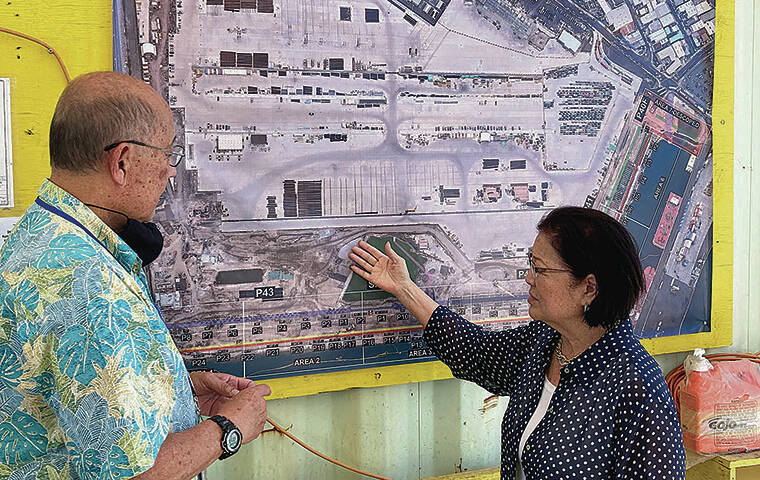A new ocean cargo container terminal at Honolulu Harbor long deemed a crucial state project supporting economic growth is on track for completion in early 2024 after nearly two decades of work that has included major delays.
The $526 million project on 84 acres of state land that was once an Army shipping and warehouse base known as Kapalama Military Reservation is expected to expand container handling capacity by 40% at the state’s largest commercial port to address overcrowding and improve efficiency in maritime commerce critical to Hawaii’s economy.
All the work, being done by construction firm Kiewit under two contracts with the state Department of Transportation, is being paid for by the state using bonds and recouped through harbor user fees.
However, state officials are being encouraged to seek federal funding for other potential harbor improvements that typically don’t receive federal transportation funding, like state airports and highways.
U.S. Sen. Mazie Hirono got a tour and update of the container terminal project Monday and encouraged DOT officials to compete for grants available through two federal spending bills recently enacted by Congress, the Infrastructure Investment and Jobs Act and the Inflation Reduction Act. “We are all working together to make that happen,” she said at the container terminal site to an audience of state officials, Kiewit representatives and others.
Jade Butay, DOT director, said he appreciates Hirono’s support and the availability of federal funding for state harbor work. “We are grateful for the discretionary grant opportunities,” he said.
Hawaii historically has had a difficult time winning such grant awards because of cost-benefit analysis that tends to favor projects in other states with bigger populations and lower costs.
The need for a new container cargo facility was identified as early as 1989 in the Honolulu Waterfront Master Plan, though earnest planning for the current project began in 2005.
Work to date has included environmental studies,
planning, permitting and relocating roughly 80 commercial tenants that had leased property on the site from the state, which acquired the area shortly after the Army ceased most military operations there in the late 1980s.
In 2014, after a key environmental review had been completed, DOT anticipated being able to finish the terminal project in 2016.
Later, after a contract
was awarded in 2017 for the project’s first phase, completion of the new terminal in two phases was projected for this year.
The initial phase of construction on inland areas, which have been raised
by 3 feet to protect against sea level rise, was finished about eight months ago
at a cost of $174 million.
A second phase with piers along the water’s edge along the Ewa end of Honolulu Harbor is costing
$352 million.
The new terminal and pier space are being built to alleviate severe congestion on Sand Island where Hawaii’s two main domestic ocean cargo transportation firms, Matson Inc. and Pasha Hawaii, share 130 acres of pier and terminal space.
Relocating Pasha to the new Kapalama Container Terminal also will accommodate business growth as Hawaii’s economy expands. About 80% of everything consumed in the state is
delivered by ship.
Another benefit from the project will allow Pasha to move containers needing neighbor island delivery to interisland cargo transportation firm Young Brothers on adjacent land without driving containers down Sand Island Access Road and Auiki Street. This new connection is expected to service about 50,000 truckloads per year, according to state officials.
State officials once projected that existing cargo terminal space at Honolulu Harbor would begin to
constrain economic growth by 2020 if not expanded, though two economic downturns over the past 20 years reduced the project’s urgency somewhat.

